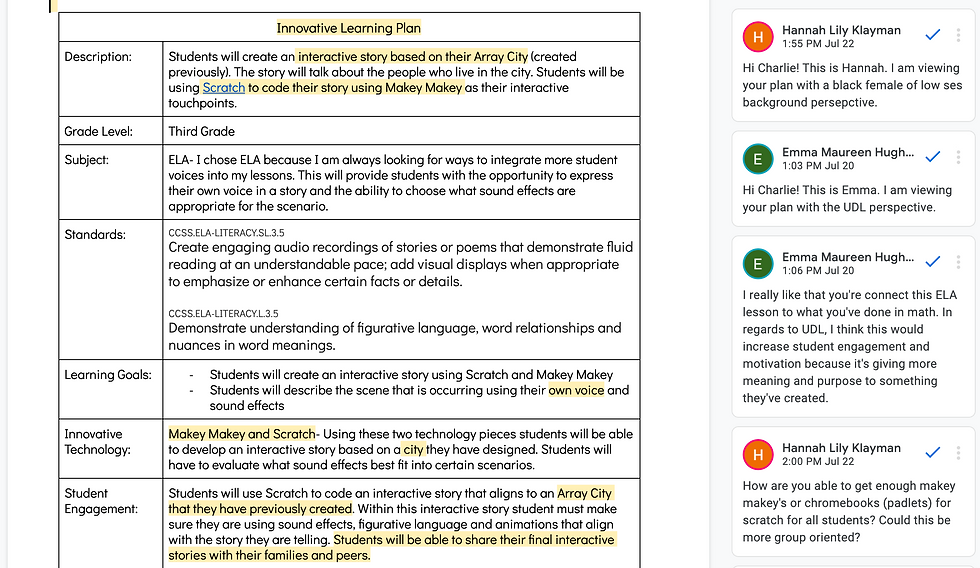Innovative Technology in the Classroom
- Charlie Jansen
- Aug 2, 2020
- 3 min read
Creating a lesson for a group of diverse learners is not an easy task. Between thinking about their different learning styles, reading levels, background knowledge, etc. Now educators have to consider if and what technology may be helpful to increase not only engagement in the lesson but also have a beneficial outcome for their students.

That is why when I was creating a lesson where I wanted to use an innovative technology I considered the Technological Pedagogical Content Knowledge (TPACK) framework. According to Joo et al. (2018) the TPACK framework “is a theoretical framework for describing the interaction and integration of technology, pedagogy, and content knowledge needed to successfully integrate technology use into teaching” (para. 9). Having this framework in mind I wanted to make sure that the innovative technology I chose was not just a part of my lesson because it was a piece of technology but because integrated with the content of my lesson.
The lesson I created allows students to have their own voice when storytelling while integrating innovative technology. The innovative technology I will be using is Scratch and for some Makey Makey. The main objective is for students to use Scratch to code a story that includes animations and sound effects from four different viewpoints that relate to an array city that they created from a previous math lesson. For those students who grasp coding quickly on Scratch they will be able to add another component of Makey Makey. This will allow them to create interactive touchpoints on their array city that relate to the different viewpoints they are storytelling from.
Another part of the lesson planning process is getting feedback. This can be a nerve-wracking time for an educator. However, you can receive some very valuable feedback when you share it. I took this leap with my innovative technology lesson and shared it with some colleagues and I was not disappointed with my feedback. My colleagues took two lenses when looking over my lesson plan, one was a lens using the Universal Design for Learning framework and the other was a lens of Intersectionality thinking of a black female student of low socioeconomic status.


Having both of these lenses view my lesson plan helped to show me the areas of strengths and areas for growth I have in my lesson. “Universal Design for Learning is an approach to instruction that promotes access, participation, and progress in the general education curriculum for all learners” (Katz J., 2013, pg. 157). I want all of my students to have access, participate and grow in my lessons. In my feedback that I received, I saw that I had a strength in this by allowing my students to use their own voice to create the stories. An area for growth I had was accessibility, what if my students were not able to use the innovative technology of Scratch independently? My initial thought was that I wanted students to come up with their stories independently and I kept this idea. However, Scratch can be a difficult technology to use so it led me to adapt my lesson plan so that students can receive support from their peers to help guide them through the coding process. Another area for growth I had was my assessment piece. Originally I was going to use just a teacher graded rubric. However, my colleague pointed out that by doing this it does not give the student a lot of voice in my lesson. This led me to change the assessment process from just being teacher graded to also providing students with the opportunity to self reflect and grade their own projects. I would then take that grade and combine it with the teacher grade and take the average of the two for a final grade.
Like I stated, in the beginning, the lesson planning process is not easy and there are a lot of components to consider. I am appreciative of those who have helped me along the way. In future lesson planning, I hope to keep these lenses in mind so that my lesson can be accessible to all students. Check out my updated innovative technology lesson.
References
Jansen C. (2020). Peer Feedback. [Image].
Jansen C. (2020). Innovative Learning Plan. https://docs.google.com/document/d/1d0Lcdni1JSgb2PYrVdfYD1MkL8ePIT_kArtGNxiug_w/edit?usp=sharing
Joo, Y. J., Park, S., & Lim, E. (2018) Factors Influencing Preservice Teachers’ Intention to Use Technology: TAPCK, Teacher Self-efficacy, and Technology Acceptance Model. Educational Technology & Society. https://link-gale-com.proxy1.cl.msu.edu/apps/doc/A550300742/AONE?u=msu_main&sid=AONE&xid=e58962f1
Katz J. (2013). The Three Block Model of Universal Design for Learning (UDL): Engaging students in inclusive education. Canadian Journal of Education/Revue Canadienne De L'éducation. 153-194. www.jstor.org/stable/canajeducrevucan.36.1.153
Mishra P. (2018). Revised version of TPACK. [Image]. http://www.tpack.org/




Comments